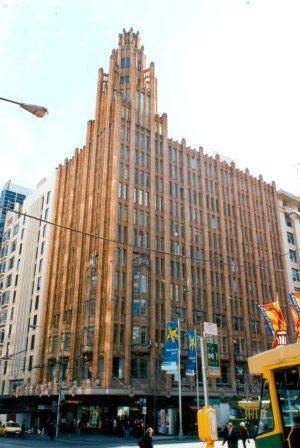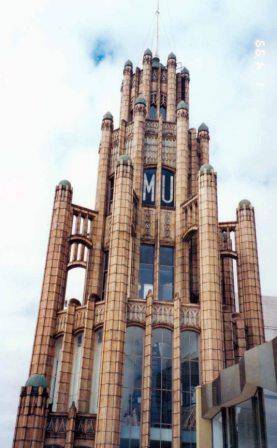| Back to search results » | Back to search page » |
|
Manchester Unity Building
Location220 - 226 Collins Street,, MELBOURNE VIC 3000 - Property No B4080
File NumberB4080LevelState |
|
Statement of Significance
No event, other than the two World Wars, has had a greater effect on the morale, economic and social life of Australians than the Great Depression of the early 1930's. The Building of the IOOF Manchester Unity Building inspired and convinced Melbournians that the building slump caused by the Depression was almost over.
The Manchester Unity IOOF purchased the property at the North West corner of Collins and Swanston Street in 1928. Previously known affectionately, by Melbournians as "Stewart Dawson's Corner', It was a popular meeting place rivalled only by the entrance to Flinders Street Station 'under the clocks'.
Architect Marcus Barlow designed the twelve storey concrete encased steel structure which reached the building limit height of 132 ft.
Site works commenced at midnight of the 1st January, 1932. Eleven months and twelve days later the building was officially opened by the Premier of Victoria. By early May 1932 the sub-basement, basement and ground floors were ready for shopfitters and other finishing trades to move in. The other floors and the roof were added at the rate of one a week and by late July the roof was laid and work started on the 78 ft. tower. This incredible rate of construction was achieved by the builder W. E. Cooper Pty. Ltd. by employing twice the normal number of building workers who worked shifts, night and day. The building programme was controlled by the use of a works progress schedule. This was an innovation to the local building industry. Newspapers carried regular reports on the progress of the building and a trip to the city to watch construction was a regular event for many Melbournians.
The Manchester Unity building was the first in Victoria to have escalators. These provided access to the basement and the first floor directly from the main arcade entrance at Swanston Street. It was also one of the first Victorian buildings with automatic cooling, rubbish and postal chutes on every floor; with three high speed lifts and the largest diesel generator made in Australia, at the time.
The exterior facade is clad in buff coloured terracota faience which lends itself to be used to emphasize the vertical, both in the main columns and the mullions separating the narrow windows. The facade generally is a good composition with solids and voids happily related, members nicely grouped and ornamental finishes linking the building together. Prominence is given to the corner by the tower which attracts attention to the building for some distance, from either of the cross streets as it soars to a height of 215 ft. Four columns are extended above the parapet to form crown buttresses to the glazed tower. The tower culminates in receding storeys, flying buttresses and pinnacles in a style similar to the Grace Building in York Street, Sydney and presumably inspired by the tower of the Chicago Tribune Building, which received world wide publicity which was built in 1927. The plans and perspectives of the Manchester Unity building were first published in October 1929.
The ground floor arcade is quite magnificent, with its marble faced walls, cast plaster ceiling panels, decorative metal framed shop fronts and beautiful panelled lift doors, all in original condition.
While the basement has been completely altered to accommodate two cinemas, all the upper floor corridors and the staircase have retained the original decor. This includes the plaster ceiling panels depicting Aboriginals, Australian Flora and Fauna as well as Transport, Building and Primary Industries. The walls are either in brown and beige marble or ceramic tiles. The glazed doors to each tenancy are quite a feature of the upper floors. The roof garden no longer exists. On the eleventh floor, the offices and board room of Manchester Unity, with excellent sliced veneer wall panelling are most notable. Two of the three lifts have been converted to automatic operation but the beautiful timber panelled interiors to the lift cars have been retained.
The Manchester Unity Building is certainly one of the great landmarks of Melbourne.
Classified: 07/11/1983
Group
Recreation and Entertainment
Category
Cinema





